新编英汉翻译教程
- 格式:ppt
- 大小:510.00 KB
- 文档页数:116
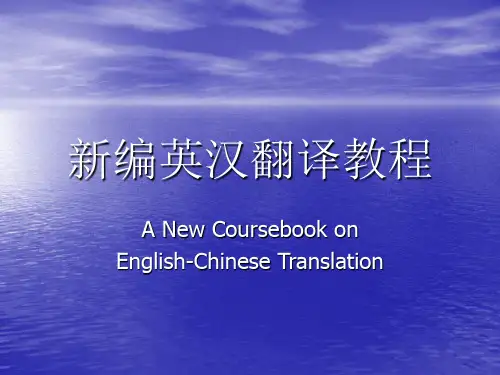

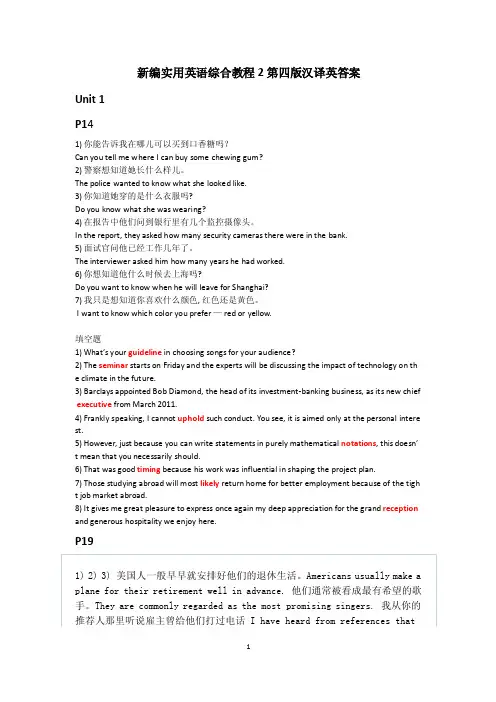
新编实用英语综合教程2第四版汉译英答案Unit 1P141) 你能告诉我在哪儿可以买到口香糖吗?Can you tell me where I can buy some chewing gum?2) 警察想知道她长什么样儿。
The police wanted to know what she looked like.3) 你知道她穿的是什么衣服吗?Do you know what she was wearing?4) 在报告中他们问到银行里有几个监控摄像头。
In the report, they asked how many security cameras there were in the bank.5) 面试官问他已经工作几年了。
The interviewer asked him how many years he had worked.6) 你想知道他什么时候去上海吗?Do you want to know when he will leave for Shanghai?7) 我只是想知道你喜欢什么颜色, 红色还是黄色。
I want to know which color you prefer — red or yellow.填空题1) What’s your guideline in choosing songs for your audience?2) The seminar starts on Friday and the experts will be discussing the impact of technology on the climate in the future.3) Barclays appointed Bob Diamond, the head of its investment-banking business, as its new chief executive from March 2011.4) Frankly speaking, I cannot uphold such conduct. You see, it is aimed only at the personal intere st.5) However, just because you can write statements in purely mathematical notations, this doesn’t mean that you necessarily should.6) That was good timing because his work was influential in shaping the project plan.7) Those studying abroad will most likely return home for better employment because of the tigh t job market abroad.8) It gives me great pleasure to express once again my deep appreciation for the grand reception and generous hospitality we enjoy here.P191) 2) 3) 美国人一般早早就安排好他们的退休生活。
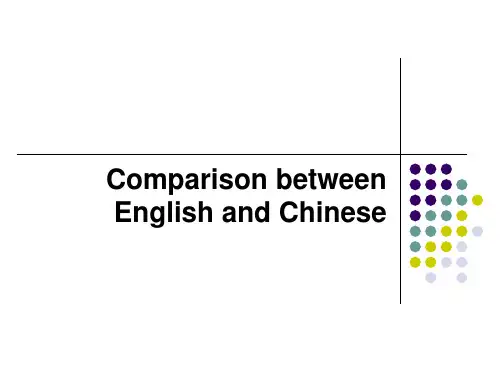
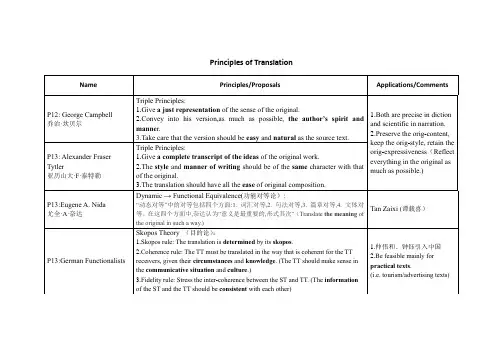
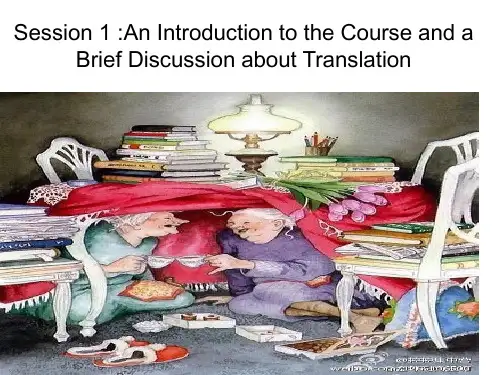
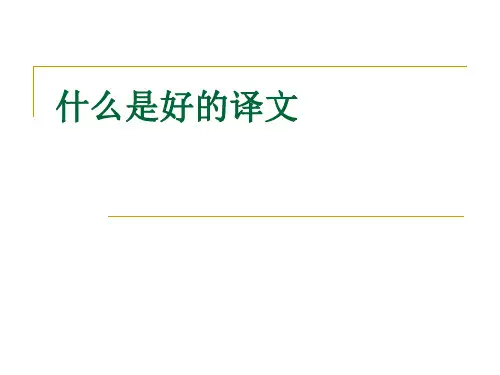
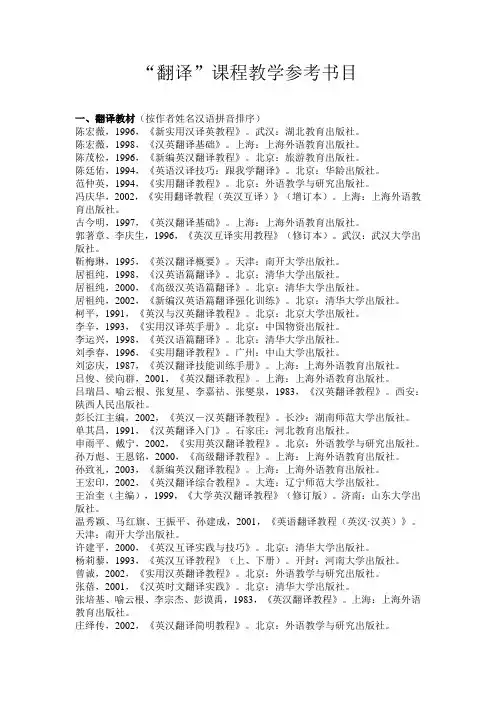
“翻译”课程教学参考书目一、翻译教材(按作者姓名汉语拼音排序)陈宏薇,1996,《新实用汉译英教程》。
武汉:湖北教育出版社。
陈宏薇,1998,《汉英翻译基础》。
上海:上海外语教育出版社。
陈茂松,1996,《新编英汉翻译教程》。
北京:旅游教育出版社。
陈廷佑,1994,《英语汉译技巧:跟我学翻译》。
北京:华龄出版社。
范仲英,1994,《实用翻译教程》。
北京:外语教学与研究出版社。
冯庆华,2002,《实用翻译教程(英汉互译)》(增订本)。
上海:上海外语教育出版社。
古今明,1997,《英汉翻译基础》。
上海:上海外语教育出版社。
郭著章、李庆生,1996,《英汉互译实用教程》(修订本)。
武汉:武汉大学出版社。
靳梅琳,1995,《英汉翻译概要》。
天津:南开大学出版社。
居祖纯,1998,《汉英语篇翻译》。
北京:清华大学出版社。
居祖纯,2000,《高级汉英语篇翻译》。
北京:清华大学出版社。
居祖纯,2002,《新编汉英语篇翻译强化训练》。
北京:清华大学出版社。
柯平,1991,《英汉与汉英翻译教程》。
北京:北京大学出版社。
李辛,1993,《实用汉译英手册》。
北京:中国物资出版社。
李运兴,1998,《英汉语篇翻译》。
北京:清华大学出版社。
刘季春,1996,《实用翻译教程》。
广州:中山大学出版社。
刘宓庆,1987,《英汉翻译技能训练手册》。
上海:上海外语教育出版社。
吕俊、侯向群,2001,《英汉翻译教程》。
上海:上海外语教育出版社。
吕瑞昌、喻云根、张复星、李嘉祜、张燮泉,1983,《汉英翻译教程》。
西安:陕西人民出版社。
彭长江主编,2002,《英汉-汉英翻译教程》。
长沙:湖南师范大学出版社。
单其昌,1991,《汉英翻译入门》。
石家庄:河北教育出版社。
申雨平、戴宁,2002,《实用英汉翻译教程》。
北京:外语教学与研究出版社。
孙万彪、王恩铭,2000,《高级翻译教程》。
上海:上海外语教育出版社。
孙致礼,2003,《新编英汉翻译教程》。
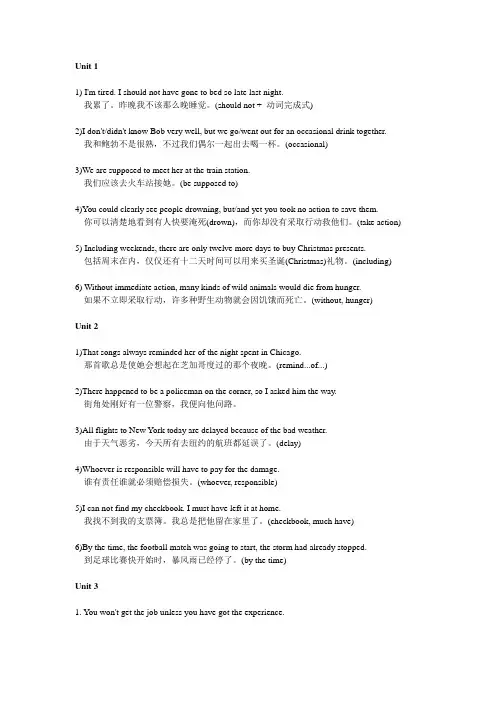
Unit 11) I'm tired. I should not have gone to bed so late last night.我累了。
昨晚我不该那么晚睡觉。
(should not + 动词完成式)2)I don't/didn't know Bob very well, but we go/went out for an occasional drink together.我和鲍勃不是很熟,不过我们偶尔一起出去喝一杯。
(occasional)3)We are supposed to meet her at the train station.我们应该去火车站接她。
(be supposed to)4)You could clearly see people drowning, but/and yet you took no action to save them.你可以清楚地看到有人快要淹死(drown),而你却没有采取行动救他们。
(take action)5) Including weekends, there are only twelve more days to buy Christmas presents.包括周末在内,仅仅还有十二天时间可以用来买圣诞(Christmas)礼物。
(including)6) Without immediate action, many kinds of wild animals would die from hunger.如果不立即采取行动,许多种野生动物就会因饥饿而死亡。
(without, hunger)Unit 21)That songs always reminded her of the night spent in Chicago.那首歌总是使她会想起在芝加哥度过的那个夜晚。
(remind...of...)2)There happened to be a policeman on the corner, so I asked him the way.街角处刚好有一位警察,我便向他问路。
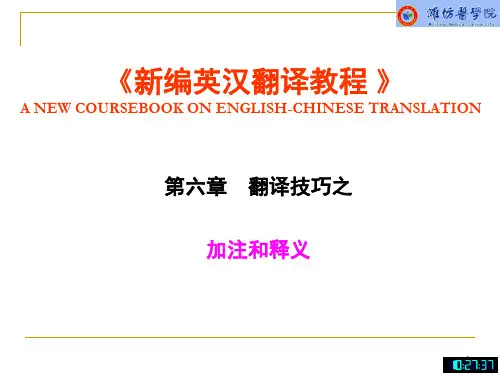
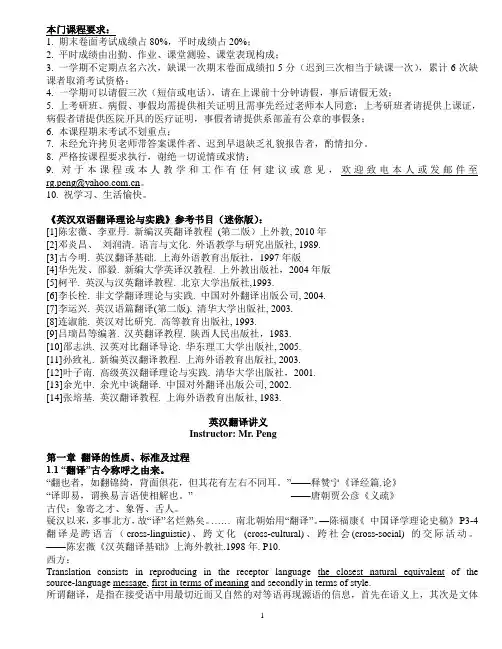
本门课程要求:1. 期末卷面考试成绩占80%,平时成绩占20%;2. 平时成绩由出勤、作业、课堂测验、课堂表现构成;3. 一学期不定期点名六次,缺课一次期末卷面成绩扣5分(迟到三次相当于缺课一次),累计6次缺课者取消考试资格;4. 一学期可以请假三次(短信或电话),请在上课前十分钟请假,事后请假无效;5. 上考研班、病假、事假均需提供相关证明且需事先经过老师本人同意;上考研班者请提供上课证,病假者请提供医院开具的医疗证明,事假者请提供系部盖有公章的事假条;6. 本课程期末考试不划重点;7. 未经允许拷贝老师带答案课件者、迟到早退缺乏礼貌报告者,酌情扣分。
8. 严格按课程要求执行,谢绝一切说情或求情;9. 对于本课程或本人教学和工作有任何建议或意见,欢迎致电本人或发邮件至rg.peng@。
10. 祝学习、生活愉快。
《英汉双语翻译理论与实践》参考书目(迷你版):[1]陈宏薇、李亚丹. 新编汉英翻译教程(第二版)上外教, 2010年[2]邓炎昌、刘润清. 语言与文化. 外语教学与研究出版社, 1989.[3]古今明. 英汉翻译基础. 上海外语教育出版社,1997年版[4]华先发、邵毅. 新编大学英译汉教程. 上外教出版社,2004年版[5]柯平. 英汉与汉英翻译教程. 北京大学出版社,1993.[6]李长栓. 非文学翻译理论与实践. 中国对外翻译出版公司, 2004.[7]李运兴. 英汉语篇翻译(第二版). 清华大学出版社, 2003.[8]连淑能. 英汉对比研究. 高等教育出版社, 1993.[9]吕瑞昌等编著. 汉英翻译教程. 陕西人民出版社,1983.[10]邵志洪. 汉英对比翻译导论. 华东理工大学出版社, 2005.[11]孙致礼. 新编英汉翻译教程. 上海外语教育出版社, 2003.[12]叶子南. 高级英汉翻译理论与实践. 清华大学出版社,2001.[13]余光中. 余光中谈翻译. 中国对外翻译出版公司, 2002.[14]张培基. 英汉翻译教程. 上海外语教育出版社, 1983.英汉翻译讲义Instructor: Mr. Peng第一章翻译的性质、标准及过程1.1 “翻译”古今称呼之由来。
翻译Unit111、他暗示John是肇事者的企图是徒劳的。
(insinuate,futile)暗示,无用的;无效的His attempt at insinuating that John was the culprit turned out to be futile.2、当他未能完成期望他做的事时,他很善于临时找个借口来为自己开脱。
(improvise)临时做He is very clever at improvising excuses when he fails to do what is expected of him.3、他此行去西藏可以满足他想参观布达拉宫的愿望了。
(gratify)使满足;使满意,使高兴His trip to Tibet will gratify his desire to see Potala. (the Potala Palace)4、这个公司拥有雄厚的人力资源。
(command)命令,指挥;控制This corporation commands excellent/rich/abundant human resources.5、另外想个办法去款待你的客人。
不要老是请他们看影视光碟。
(alternative)二中择一;供替代的选择Think of an alternative way of entertaining your guests. Don’t always show them VCDs.6、沉溺于胡思乱想和心血来潮是有害的。
(caprice)任性,反复无常;随想曲It is harmful to indulge in whims and caprices.7、不属于你的东西不要作非分之想。
(lay one’s hands on,be entitled to)2有权;有…的资格Try not to lay your hands on anything that you are not entitled to.8、他没有来参加竞赛。
广西师范学院《英汉互译(一)》课程教案编号: 15-1 开课单位:外语系授课教研室:翻译写作课程名称:《英汉互译(一)》授课教师:唐旭光教材:《新编英汉互译教程》,授课对象:06级英语专业2、3、5班《英汉互译(一)》第一讲翻译简论与主要翻译方法(A Brief Discussion of Translation and Major Translation Approaches)1. IntroductionTranslation studies started along with translation practice. Translation theories developed flourishingly in the 20th century, especially in the second half of the last century.In fact, translation, which is a very complex phenomenon, is related to different disciplines, such as linguistics, psychology, sociology, cultural anthropology, communication theory, literary criticism, aesthetics, and semiotics. As translation study is a cross-discipline and cross-culture subject involving many aspects of human knowledge, the lack of a fully acceptable theory of translation should not come as a surprise. Meanwhile, quite a number of translation approaches and strategies have become universally acceptable and widely applicable. They are, of course, the fruits of many translation theorists and translation practitioners at home and abroad.2.The Origin of TranslationLanguage makes it possible for people to communicate with one another freely so as to complete important tasks in human life. Translation makes it possible for people from different languages to communicate with one another so as to complete important tasks in their life.Theodore Savory points out, “Translation is almost as old as original authorship and has a history as honorable and as complex as that of any other branch of literature”(申雨平, 2002:4).In Zhou Dynasty there were different forms of address for translators in different places. “Translators are called Ji in the east, Xiang in the south, Didi in the west, andYi in the north(东方曰寄,南方曰象,西方曰狄鞮,北方曰译)”(陈福康, 2000:3).3. Function of TranslationIt has helped people to better communicate with one another, and in the mean time it has facilitated the development of culture and civilization of all nations, such as the Sutra translation (佛经翻译)in China and the Bible translation in Western countries.Actually, translation, as a means to bridge different cultures, has been playing a very important role in promoting global economic and cultural development, and China in particular benefits a great deal from translation, which is obvious to all.4. Nature of translationOne school of theorists maintain that any interpretation is translation. Translation thus defined includes intra-lingual rewording(语言内的重新措辞), inter-lingual (语言之间的翻译或语际翻译)translation and inter-semiotic transmutation(符号转换).But most scholars who are interested in translation maintain that translation is a communicative activity which entails a most adequate or identical reproduction in a target language of a written message or text in a source language.5. Definition of translation in our textbook as follows: Translation or translating is a communicative activity or dynamic process in which the translator makes great effort to thoroughly comprehend a written message or text in the source language and works very hard to achieve an adequate or an almost identical reproduction in the target language version of the written source language message or text. In terms of its nature or character, translation is both an art and a science as well, since it calls for a good command of at least two languages, a flexible application of their rules, and some knowledge of at least two cultures, as well as a good grasp of the necessary translation theories.6. Other scholars’ viewpoints about the translation1). The traditional viewpoint about the nature of translation is that translation is an art only. This viewpoint is still maintained by Xu Yuanchong(许渊冲), a well-known professor at Beijing University, and a few other scholars.2). Professor Liu Zhongde vigorously advocates that translation is a science as well as an art mainly because of the following reasons:Firstly, like any other art and science, translation requires a good grasp and a flexible use of the necessary specialized knowledge and skills.Secondly, like any other art and science, translation calls for independent, honest and creative effort.Thirdly, just like any other art and science, translation demands that the translator be very careful about and highly responsible for his or her work.7. Principle for translationThe 13 statements on page 81). A translation must reproduce the words of the SLT(Source Language Text).2). A translation must reproduce the ideas (meaning) of the SLT.3). A translation should read like an original work.4). A translation should read like a translation.5). A translation should reflect the style of the original.6). A translation should possess the style of the translator.7). A translation should retain the historical stylistic dimension of the SLT.8). A translation should read as a contemporary piece of literature.9). A translation may add to or omit from the original.10). A translation may never add to or omit from the original.11). A translation should let the readers of the SLT and the target language text (TLT) have essentially the same response.12). A translation should convey what the SLT author intends to convey.13). A translation should satisfy the need of the client.Evidently, though each of the above statements is right in a certain sense, yet it is not adequate or comprehensive enough to serve as a translation principle. Some of the principles proposed by various translation theorists can find their expression in the statements given above. Interlinear translation is an illustration of the first statement. Yan Fu’s three-character principle can be a combination of statements 2, 3 and 6. Nida’s functional equivalence is best express ed in statement 11.8. Yan Fu’s Considerations for translation?Strictly speaking, a translation theory in its true sense in China originated from Yan Fu(严复). He proposed the famous triple principle for translation, namely, faithfulness(信), expressiveness(达) and elegance(雅).1). His faithfulness means that the translated text should be faithful to the original text, ie, the version should keep the content or ideas of the original.2). His expressiveness means that the translated text should be expressive and coherent without anything awkward. In other words, his expressiveness requires that the version should be fluid, smooth, and easy to read and understand.3). His elegance demands that the translated text should be exquisite and that its style ought to be very graceful.9. Professor Liu Zhongde argues against “elegance” as a principle for translation of the original styleHe argued eloquently against “elegance” as a principle for translation of the original style. We all know that not all works are characterized by the elegant style. Different writers display different styles. For instance, Lenin wrote in a bold style, and Hemingway wrote in a simple, symbolic style. Even the same writer shows different styles on different occasions for different purposes. Naturally, different works demonstrate different styles. Thus, it is impossible & absolutely wrong to achieve the effect of elegance in the translated text if the style of the original is not elegant.10. The compiler of the textbook in favor of “closeness”1). We are in favor of Professor Liu’s triple translation principle. He changed Yan Fu’s “elegance” into “closeness”, which represents his contribution to the translation theory. His “closeness” is central in meaning. It is suitable for translation of all types of texts with different styles.2). If the original text is characterized by the elegant style, the translator should do his utmost to render it into a graceful text in the target language whose style is close to the original elegant style.If the original style is highly technical with a wealth of technical terms, thetranslator ought to employ plenty of corresponding technical terms in the target language and make the translated style as close to the original technical style as possible.3). If the original style is colloquial with a lot of informal words and colloquial sentences, the translator should translate it into a text with an informal style as close as possible to the original one by using many colloquial words and informal sentences.If the original style is ornate, the translator should follow suit and make effort to render the translated style as close to the original as possible.If the original text contains some vulgar words and sentences, the translator is not entitled to replace them with elegant words or sentences, and he should reproduce the original by using some corresponding vulgar words and sentences in the receptor language. Translators are duty-bound to do so, for the simple reason that they are translators.4). As we know, Yan Fu’s triple translation principle is highly concise and well rhymed and quite easy to learn by heart, which is one of the reasons why it is still very popular in China today.Professor Liu’s triple principle is similar to Yan Fu’s in that it is equally concise and easy to remember.Though Professor Liu’s triple principle is n ot rhymed, yet it is very forceful and impressive, for the Chinese character “切” is uttered in the falling tone, carrying the implication that faithfully conveying the original style or rendering the translated style as close to the original as possible is absolutely necessary and worth the translator’s great effort.11. Nida’s principle for translationEugene A. Nida and Taber stated emphatically (1969:12): “Translation consists in reproducing in the receptor language the closest natural equivalence of the source language message, first in terms of meaning and secondly in terms of style”.His dynamic equivalence is defined as a translation principle, according to which the translator seeks to translate the meaning of the original in such a way that the target language text wording will produce the same impact on the target text audience as the original wording does upon the source text audience. Later on, Nida changed “dynamic equivalence” into “functional equivalence”, because it seemed much more satisfactory to use the expression “functional equivalence” in describing the degree of adequacy of a translation.12. The literal translation approachProfessor Liu Zhongde (1994: 172) defines literal translation as follows: “In the process of translation, literal translation treats sentences as basic units and at the same time takes the whole passage into consideration; a translator who attaches great importance to literal translation does his or her best to reproduce the ideas and writing style of the original work, retaining in the version as many rhetorical devices and sentence structures of the original as possible.”ExamplesHe is said to be a rough diamond.人们说他是一块浑金璞玉。
“翻译”课程教学参考书目史宝辉(辑)一、翻译教材(按作者姓名汉语拼音排序)陈宏薇,1996,《新实用汉译英教程》。
武汉:湖北教育出版社。
陈宏薇,1998,《汉英翻译基础》。
上海:上海外语教育出版社。
陈茂松,1996,《新编英汉翻译教程》。
北京:旅游教育出版社。
陈廷佑,1994,《英语汉译技巧:跟我学翻译》。
北京:华龄出版社。
范仲英,1994,《实用翻译教程》。
北京:外语教学与研究出版社。
冯庆华,2002,《实用翻译教程(英汉互译)》(增订本)。
上海:上海外语教育出版社。
古今明,1997,《英汉翻译基础》。
上海:上海外语教育出版社。
郭著章、李庆生,1996,《英汉互译实用教程》(修订本)。
武汉:武汉大学出版社。
靳梅琳,1995,《英汉翻译概要》。
天津:南开大学出版社。
居祖纯,1998,《汉英语篇翻译》。
北京:清华大学出版社。
居祖纯,2000,《高级汉英语篇翻译》。
北京:清华大学出版社。
居祖纯,2002,《新编汉英语篇翻译强化训练》。
北京:清华大学出版社。
柯平,1991,《英汉与汉英翻译教程》。
北京:北京大学出版社。
李辛,1993,《实用汉译英手册》。
北京:中国物资出版社。
李运兴,1998,《英汉语篇翻译》。
北京:清华大学出版社。
刘季春,1996,《实用翻译教程》。
广州:中山大学出版社。
刘宓庆,1987,《英汉翻译技能训练手册》。
上海:上海外语教育出版社。
吕俊、侯向群,2001,《英汉翻译教程》。
上海:上海外语教育出版社。
吕瑞昌、喻云根、张复星、李嘉祜、张燮泉,1983,《汉英翻译教程》。
西安:陕西人民出版社。
彭长江主编,2002,《英汉-汉英翻译教程》。
长沙:湖南师范大学出版社。
单其昌,1991,《汉英翻译入门》。
石家庄:河北教育出版社。
申雨平、戴宁,2002,《实用英汉翻译教程》。
北京:外语教学与研究出版社。
孙万彪、王恩铭,2000,《高级翻译教程》。
上海:上海外语教育出版社。
孙致礼,2003,《新编英汉翻译教程》。
第1章绪论1.1 复习笔记一、翻译的性质与类型1. 翻译的意义翻译是将一种语言文化承载的意义转换到另一种语言文化中的跨语言、跨文化的交际活动。
翻译的本质是释义,是意义的转换。
翻译活动涉及诸多因素:译者(translator)、作者(author)、原文(source text)、原文读者(source-text readers)、译文(target text/translated text/target version)、译文读者(target-text readers)等。
2. 翻译的类型①就文本而言,翻译可分为文学翻译、科技翻译和应用文翻译。
②就方式而言,主要有全译、摘译和编译。
二、汉英翻译的单位翻译单位可以决定在什么层级上实现翻译的标准。
汉语和英语的语言层级均有词(word)、短语(phrase)、句子(sentence)、段落(paragraph)和篇章(text)。
对初学者来说,句子是较为理想的翻译单位。
但是汉语句子只是语义相对完整的一个单位,它与相邻句子之间必然存在语义上的关联,所以不可孤立地翻译句子而忽视句子之间的关系。
三、汉英翻译的标准1. 中国的翻译标准在中国,严复的“信、达、雅”(faithfulness, expressiveness and elegance)是影响最深、流传最广的翻译标准。
该三字标准最早出现于佛经翻译家支谦的《法句经序》中。
文学翻译家黄龙先生对严复提出的翻译标准倍加欣赏,并赋予“信、达、雅”新的内涵和生命,其标准适用于文学翻译。
另一位翻译家刘重德先生在严复的基础上,提出了“信达切”(faithfulness, expressiveness and closeness)的翻译标准。
“信”指信于原文内容(to be faithful to the content of the original);“达”指具备原文一样的表现力(to be as expressive as the original);“切”指尽可能切近原文风格(to be as close to the original style as possible)。
《新编大学英译汉教程》中drag的理解作者:黄卫峰来源:《中国科技术语》2009年第01期摘要:《新编大学英译汉教程》是目前中国高校英语专业采用比较多的一本普通高等教育“十五”国家级规划教材,然而该教材在科技英语翻译部分所举的例子中存在一处明显的翻译理解错误。
关键词:翻译教材,术语,理解错误Abstract:k for English majors in the university of China, there is an obvious misunderstanding in the translation of a scientific term.Key words:translation textbook, term, misunderstanding上海外语教育出版社出版的《新编大学英译汉教程》(华先发、邵毅,2007)中有这样一个例子:and drag substantially.(第263页)教材提供的中文参考译文为:位于德比郡的铁路技术中心的英国铁路工程师大大削减了列车的重量,增加了牵引力。
(第335页)对比译文与原文,读者可以发现,原文中的同一个动词trim在译文中被处理成了两个意义完全相反的动词——“削减”和“增加”。
把trimmed the train’s weight翻译成“削减了列车的重量”,没有任何问题。
但“增加了牵引力”是如何翻译出来的呢?有两种可能:第一种可能是由于粗心大意误解原文结构,把drag理解为动词,而drag确实有“拖,拉,牵引”的意思;第二可能是译文对trimmed drag作了正反转换处理。
也就是说,译者认为,drag是“牵引力”的反义词,这就涉及专业科技知识问题。
首先,来看drag的意义。
查词典可知,该词是多义词,根据语境可以确定,该词在本句中的意思应该是:the retarding force exerted on a moving body by a fluid medium such as air or water或the force of the air that acts against the forward movement of an aircraft or vehicle,即“阻力”或“空气阻力”。